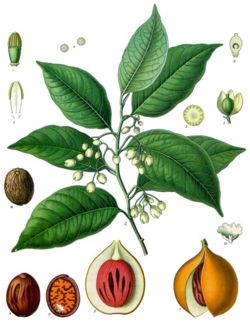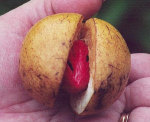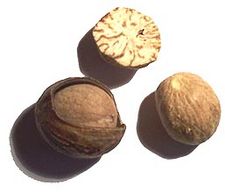Nutmeg
2007 Schools Wikipedia Selection. Related subjects: Food and agriculture
| iNutmeg | ||||||||||||
|---|---|---|---|---|---|---|---|---|---|---|---|---|
 Myristica fragrans
|
||||||||||||
| Scientific classification | ||||||||||||
|
||||||||||||
|
|
||||||||||||
|
About 100 species, including:
|
The nutmegs Myristica are a genus of evergreen trees indigenous to tropical southeast Asia and Australasia. They are important for two spices derived from the fruit, nutmeg and mace.
Nutmeg is the actual seed of the tree, roughly egg-shaped and about 20-30 mm long and 15-18 mm wide, and weighing between 5 and 10 grams dried, while mace is the dried "lacy" reddish covering or arillus of the seed.
Several other commercial products are also produced from the trees, including essential oils, extracted oleoresins, and nutmeg butter (see below).
The pericarp (fruit/pod) is used in Grenada to make a jam called Morne Delice. In Indonesia, the fruit is sliced finely, cooked and crystallised to make a fragrant candy called manisan pala ("nutmeg sweets").
The most important species commercially is the Common or Fragrant Nutmeg Myristica fragrans, native to the Banda Islands of Indonesia; it is also grown in the Caribbean, especially in Grenada. Other species include Papuan Nutmeg M. argentea from New Guinea, and Bombay Nutmeg M. malabarica from India; both are used as adulterants of M. fragrans products.
Culinary uses
Nutmeg and mace have similar taste qualities, nutmeg having a slightly sweeter and mace a more delicate flavor. Mace is often preferred in light-coloured dishes for the bright orange, saffron-like colour it imparts. It is nice in cheese sauces and is best grated fresh (see nutmeg grater).
In Indian cuisine, nutmeg is used almost exclusively in sweets. It is known as jaiphal in most parts of India. It is also used in small quantities in garam masala.
In other European cuisine, nutmeg and mace are used especially in potato dishes and in processed meat products; they are also used in soups, sauces and baked goods.
Japanese varieties of curry powder include nutmeg as an ingredient.
Nutmeg is a traditional ingredient in mulled cider, mulled wine, and eggnog.
Essential oils
The essential oil is obtained by the steam distillation of ground nutmeg and is used heavily in the perfumery and pharmaceutical industries. The oil is colorless or light yellow and smells and tastes of nutmeg. It contains numerous components of interest to the oleochemical industry, and is used as a natural food flavouring in baked goods, syrups (e.g. Coca Cola), beverages, sweets etc. It replaces ground nutmeg as it leaves no particles in the food. The essential oil is also used in the cosmetic and pharmaceutical industries for instance in tooth paste and as major ingredient in some cough syrups. In traditional medicine nutmeg and nutmeg oil were used for illnesses related to the nervous and digestive systems. Myristicin and elemicin are believed to be the chemical constituents responsible for the subtle hallucinogenic properties of nutmeg oil. Other known chemical ingredients of the oil are α-pinene, sabinene, γ-terpinene and safrole.
Externally, the oil is used for rheumatic pain and, like clove oil, can be applied as an emergency treatment to dull toothache. Put 1-2 drops on a cotton swab, and apply to the gums around an aching tooth until dental treatment can be obtained. In France, it is given in drop doses in honey for digestive upsets and used for bad breath. Use 3-5 drops on a sugar lump or in a teaspoon of honey for nausea, gastroenteritis, chronic diarrhea, and indigestion.
Alternatively a massage oil can be created by diluting 10 drops in 10 ml almond oil. This can be used for muscular pains associated with rheumatism or overexertion. It can also be combined with thyme or rosemary essential oils. To prepare for childbirth, massaging the abdomen daily in the three weeks before the baby is due with a mixture of 5 drops nutmeg oil and no more than 5 drops sage oil in 25 ml almond oil has been suggested.
Nutmeg butter
Nutmeg butter is obtained from the nut by expression. It is semi solid and reddish brown in colour and tastes and smells of nutmeg. Approximately 75% (by weight) of nutmeg butter is trimyristin which can be turned into myristic acid, a 14-carbon fatty acid which can be used as replacement for cocoa butter, can be mixed with other fats like cottonseed oil or palm oil, and has applications as an industrial lubricant.
History
There is some evidence that Roman priests may have burned nutmeg as a form of incense, although this is disputed. It is known to have been used as a prized and costly spice in the Middle Ages. Saint Theodore the Studite was famous for allowing his monks to sprinkle nutmeg on their pease pudding when required to eat it. In Elizabethan times it was believed that nutmeg could ward off the plague, so nutmeg was very popular. Nutmeg was traded by Arabs during the Middle Ages in the profitable Indian Ocean trade.
In the late 15th century, Portugal theoretically took over the Indian Ocean trade, including nutmeg, under the Treaty of Tordesillas with Spain and a separate treaty with the sultan of Ternate. But their control of this trade was always only partial and they remained largely participants, rather than overlords. The authority Ternate held over the nutmeg-growing centre of the Banda Islands was quite limited, and the Portuguese failed to gain a serious foothold in the islands themselves. The trade in nutmeg later became dominated by the Dutch in the 17th century, who managed to establish control over the Banda Islands after an extended military campaign that culminated in the massacre or expulsion of most of the islands' inhabitants in 1621. Thereafter, the Banda Islands were run as a series of plantation estates, with the Dutch mounting annual expeditions in local war-vessels to extirpate nutmeg trees planted elsewhere.
As a result of the British interregnum during the Napoleonic Wars, the English took temporary control of the Banda Islands from the Dutch and transplanted nutmeg trees to their own colonial holdings elsewhere, notably Zanzibar and Grenada.
Connecticut gets its nickname ("the Nutmeg State", " Nutmegger") from the legend that some unscrupulous Connecticut traders would whittle "nutmeg" out of wood, creating a "wooden nutmeg" (a term which came to mean any fraud) .
World production
World production of nutmeg is estimated to average between 10,000 and 12,000 tonnes per year with annual world demand estimated at 9,000 tonnes; production of mace is estimated at 1,500 to 2,000 tonnes. Indonesia and Grenada dominate production and exports of both products with a world market share of 75% and 20% respectively. Other producers include India, Malaysia, Papua New Guinea, Sri Lanka and Caribbean islands such as St. Vincent. The principal import markets are the European Community, the United States, Japan and India. Singapore and the Netherlands are major re-exporters.
A possible future use for nutmeg is as a natural control for insects that infest stored cereal grains.
At one time, nutmeg was one of the most valuable spices. It has been said that in England, several hundred years ago, a few nutmeg nuts could be sold for enough money to enable financial independence for life.
The first harvest of nutmeg trees takes place 7-9 years after planting and the trees reach their full potential after 20 years.
Risks and toxicity
In low doses, nutmeg produces no noticeable physiological or neurological response. Large doses of 7.5 g or more are dangerous, potentially inducing convulsions, palpitations, nausea, eventual dehydration, and generalized body pain. In amounts of 1.0 g or more it is a mild to medium hallucinogen, producing visual distortions and a mild euphoria. It is a common misconception that nutmeg contains monoamine oxidase inhibitors (MAOI's). This is untrue; nutmeg should not be taken in combination with MAOI's but it does not contain them . A test was carried out on the substance which showed that, when ingested in large amounts, nutmeg takes on a similar chemical make-up to MDMA (ecstasy). However, use of nutmeg as a recreational drug is unpopular, because of its strong taste and sand-like texture. Also there are potential painful physical side effects, the risk of Nutmeg Psychosis (see below) and the inconveniently long span for which the effects of a single dose can persist. A user will not experience a peak until approximately six hours after ingestion, and effects can linger for up to three days afterwards. Any unpleasant side-effects would persist throughout this period.
A risk in any large-quantity ingestion of nutmeg is the sudden onset of Nutmeg Psychosis, an acute psychiatric disorder marked by hallucinations, excitement, thought disorder, a sense of impending death and agitation. Some cases have resulted in hospitalization and reportedly few who have experienced the effects of nutmeg poisoning recommend it or repeat the experience.
Even in smaller doses, nutmeg can still be toxic. Ingestion of as little as 3 g may cause dry mouth, fast pulse, fever, flushing and posibly death. It has amphetamine-like effects and may cause the desire to ingest of large volumes of water. There is no specific antidote; the adverse effects wear off after 24 hours (or more) of rest.
Nutmeg is extremely toxic when injected intravenously. Nutmeg can also cause liver damage if used regularly in large quantities. Nutmeg has in the past been used as an abortifacient. Nutmeg may also be fatal if used regularly in large quantities, but this is not a problem while cooking, since small amounts are used.

